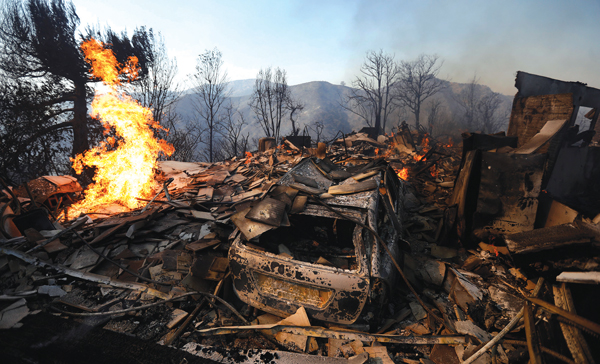Trending
Market ‘healthy’ after wildfires

Drivers on the 405 Freeway were met with an apocalyptic scene on Dec. 6, when flames engulfed the surrounding hillsides, threatening the nearby Getty Museum. Social media accounts likened it to an erupting volcano or a fiery hellscape.
The Skirball fire destroyed six homes in Los Angeles’ ritzy Bel Air neighborhood and damaged 12 other structures in the 10 days it burned. Not far from Los Angeles, firefighters were already battling the Thomas fire, which sparked in Santa Paula and burned for more than a month, becoming the state’s largest fire on record. It swept through Ventura and Santa Barbara counties, claiming two lives and destroying over 1,000 structures.
All told, the cost of the fires will probably be in the hundreds of billions of dollars, although the final number is not yet available, according to the L.A. Times.
Wildfires are hardly uncommon in Southern California. But widely shared footage of the blaze, plus evacuations of high-profile residents like Chrissy Teigen and Chelsea Handler, left some in the real estate community on edge.
Delayed but not deterred
While images of the fire may have delayed potential homebuyers, agents and developers in the areas said things are now returning to normal. “For real estate purposes, these types of things are very short-lived memories,” said developer and Eighty8 broker David Yun.
In October, he bought an approximately 2,800-square-foot house on Linda Flora Drive — to the east of the 405 — for $2.3 million, with plans to more than double its size. The fire came within 50 yards of the site, Yun said. Nearby homes burned down to their foundations. Still, he doesn’t believe that will affect his ability to sell the home once it’s remodeled: “It’s a prime location — it has a view, you can see the ocean, you can see the Getty.”
Sales haven’t dwindled on nearby Moraga Drive, a luxury enclave that lost several homes to the Skirball fire, according to Pacific Union International agent Samantha Nugent. Its “spectacular views” and the privacy its homes provide have helped it maintain its appeal in the wake of natural disaster, she explained.
 But, she conceded, in the weeks immediately after the fire, she and other agents took some listings down. The property she delisted never returned to the market, but Nugent said the fire was only part of the reason. In the end, the seller decided to keep the property, she said.
But, she conceded, in the weeks immediately after the fire, she and other agents took some listings down. The property she delisted never returned to the market, but Nugent said the fire was only part of the reason. In the end, the seller decided to keep the property, she said.
Pacific Union agent Gwen Fritzinger, who grew up on Moraga, said she hasn’t seen long-term damage to the market in the area, either. Two homes on Moraga Drive sold for around $12.3 million and $10 million in January, and a five-bedroom house on the nearby Casiano Road — where two homes were destroyed by the fire — sold for $4.72 million that same month, she recalled. In February, a five-bedroom house on Linda Flora sold for around $7.1 million.
“I think [the fire] maybe stopped things for a few weeks, and that’s about it. We have a pretty healthy market,” she said.
West of the 405
In luxury markets like Malibu, Pacific Palisades and Brentwood, home sales haven’t been affected, according to Compass agent Ryan Jancula. He sold two properties in Pacific Palisades — for around $5.5 million and around $5.2 million — and leased out a third for $18,000 a month after the Skirball fire had already wrought its devastation.
Still, during the Thomas fire and the mudslides that followed it, a number of properties in areas like Montecito came off the market. Jancula also said he has noticed more interest in fire prevention, though he noted more concern comes from out-of-towners than locals. Most buyers aren’t discouraged by the possibility of natural disasters when they’re seeking hillside homes with breathtaking views, Jancula said. “It just comes as a risk of living in Los Angeles.”
Randy Solakian, an agent at Coldwell Banker Global Luxury who focuses on Montecito, Santa Barbara and Hope Ranch, said the Montecito community is in “very good shape” after the disasters. “The town has been wounded. … It was a shock to all of us,” he said. “Having said that, escrows began closing almost immediately after the damage subsided, repairs and cleanup began the same morning of the debris slides, and it’s been ongoing on a very large scale ever since then.”
The post-fire market saw a $14 million property closing, followed by a $35 million closing — a “very big number for Montecito,” Solakian noted. The market in Santa Barbara, he said, is “very healthy right now.”
Commercial hits
Montecito and Santa Barbara’s commercial markets may take longer to recover, according to Radius Commercial Real Estate & Investments principal Brad Frohling.
Ash blanketed Montecito, including the retail corridors, for all of December, a key month for retail.“You had sort of the perfect storm — loss of income, loss of revenue,” Frohling said, noting that many tenants are still waiting on insurance claims and working with their landlords to “try to get back to good standing.”
In addition, the cleanup efforts in Montecito have increased truck traffic and created congestion for businesses along the commercial corridor.
“That is not a permanent thing, but it definitely has impacted a lot of people,” Frohling said. The devastation may also give potential businesses pause, he added.
For builders, the fire has created supply-and-demand consequences. Chris Tourtellotte of LaTerra Development, which constructs apartment and mixed-use urban infill projects around L.A., hasn’t had to modify any of his projects, as they weren’t in high-risk fire areas; however, labor has been in short supply since the blazes.
“Quite a bit of labor has been diverted to cleanup efforts and reconstruction efforts where the fires were,” he said, noting the construction labor market was already tight.
Perhaps the common thread among real estate professionals in the areas affected by the natural disasters has been optimism about the ability to recover.
Linda Flora developer Yun, for one, said he plans to buy more property in the area near the 405 and the Getty Museum. “Going a year and a half, two years … [the Skirball] is going to be pretty much a memory,” Yun said.




